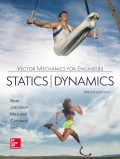
Concept explainers
15.113 and 15.114 A 3-in.-radius drum is rigidly attached to a 5-in.- radius drum as shown. One of the drums rolls without sliding on the surface shown, and a cord is wound around the other drum. Knowing that at the instant shown end D of the cord has a velocity of 6 in./s and an acceleration of 20 in./s2, both directed to the right, determine the accelerations of points A, B, and C of the drums.

Fig. P15.114
Want to see the full answer?
Check out a sample textbook solution
Chapter 15 Solutions
Vector Mechanics for Engineers: Statics and Dynamics
Additional Engineering Textbook Solutions
Machine Tool Practices (10th Edition)
Statics and Mechanics of Materials (5th Edition)
Applied Statics and Strength of Materials (6th Edition)
Applied Fluid Mechanics (7th Edition)
Fluid Mechanics: Fundamentals and Applications
INTERNATIONAL EDITION---Engineering Mechanics: Statics, 14th edition (SI unit)
- A 3-in.-radius drum is rigidly attached to a 5-in.-radius drum as shown. One of the drums rolls without sliding on the surface shown, and a cord is wound around the other drum. Knowing that at the instant shown. point A has a velocity of 5.75 in./s and an acceleration of 19 in./s2, both directed to the right, determine the accelerations of points A, B, and C of the drums. a) The accelerations of point B is _ upward? b) The accelerations of point A is _ and _? (magnitude and direction) c) The accelerations of point C is _ and _? (magnitude and direction)arrow_forward15.115 and 15.116 A 60-mm-radius drum is rigidly attached to a 100-mm-radius drum as shown. One of the drums rolls without sliding on the surface shown, and a cord is wound around the other drum. Knowing that at the instant shown end D of the cord has a velocity of 160 mm/s and an acceleration of 600 mm/s², both directed to the left, determine the accel- erations of points A, B, and C of the drums. a D 100 mm G 60 mm 40 B Carrow_forwardonly HANDWRITTEN answer needed ( NOT TYPED)arrow_forward
- B10arrow_forwardProblem (8) The belt shown moves over two pulleys without slipping. At the instant shown the pulleys are rotating clockwise and the speed of point B on the belt is 4 m/s, increasing at the rate of 32 m/s?. Determine, at this instant, (a) the angular velocity and angular acceleration of each pulley, (b) the acceleration of point P on pulley C. B 160 mm fi00 mmarrow_forward15.113 The 360-mm-radius flywheel is rigidly attached to a 30-mm- radius shaft that can roll along parallel rails. Knowing that at the instant shown the center of the shaft has a velocity of 24 mm/s and an acceleration of 10 mm/s, both directed down to the left, determine the acceleration (a) of point A, (b) of point B. A 2₂x 360 mm- 20° Barrow_forward
- A carriage c is supported by a caster A and a cylinder B each of 60 mm diameter. Knowing that at an instant the carriage has an acceleration of 3 m/s^2 and a velocity of 2 m/s , both directed to the left , calculate the angular accelerations of the caster and of the cylinder then calculate the accelerations of the centers of the caster and of the cylinder?arrow_forward6) Bar BDE is attached to two links AB and CD. Knowing that at the instant shown link AB rotates with a constant angular velocity of 3 rad/s clockwise, determine the acceleration (a) of point D, (b) of point E. 19.1 cm 19.1 cm C -30.5 cm -22.9 cm- B ODarrow_forwardRequired information NOTE: This is a multi-part question. Once an answer is submitted, you will be unable to return to this part. For a 5-m steel beam AE, the acceleration of point A is 2.5 m/s² downward and the angular acceleration of the beam is 1.5 rad/s2 counterclockwise. Knowing that at the instant considered the angular velocity of the beam is zero, determine the acceleration of cable B and cable D. A -1.5 m- B Determine the acceleration of cable B The acceleration of cable Bis 2 m 1.375 5 m/s2. D -1.5 m- Earrow_forward
- 5.- Knowing that at the instant shown bar AB has an angular velocity of 4 rad/s and an angular acceleration of 2 rad/s?, both clockwise, determine the angular acceleration (a) of bar BD, (b) of bar DE by using the vector approach. 100 mm 175 mm - B A 200 mm 75 mm D Earrow_forwardProblem (1) A belt-driven pulley and attached disk are rotating with increasing angular velocity. If at a given instant, the speed of the belt is v = 1.5 m/s, and the total acceleration of point A is 100 m/s?, determine: (a) The angular acceleration a of the pulley and disk (b) The total acceleration of point B (c) The acceleration of point C on the belt. A 150 mm 200 mmarrow_forwardplease show presentation, drawing diagram, vector’s forces & position, etc.. and showing work steps. thank youarrow_forward
 Elements Of ElectromagneticsMechanical EngineeringISBN:9780190698614Author:Sadiku, Matthew N. O.Publisher:Oxford University Press
Elements Of ElectromagneticsMechanical EngineeringISBN:9780190698614Author:Sadiku, Matthew N. O.Publisher:Oxford University Press Mechanics of Materials (10th Edition)Mechanical EngineeringISBN:9780134319650Author:Russell C. HibbelerPublisher:PEARSON
Mechanics of Materials (10th Edition)Mechanical EngineeringISBN:9780134319650Author:Russell C. HibbelerPublisher:PEARSON Thermodynamics: An Engineering ApproachMechanical EngineeringISBN:9781259822674Author:Yunus A. Cengel Dr., Michael A. BolesPublisher:McGraw-Hill Education
Thermodynamics: An Engineering ApproachMechanical EngineeringISBN:9781259822674Author:Yunus A. Cengel Dr., Michael A. BolesPublisher:McGraw-Hill Education Control Systems EngineeringMechanical EngineeringISBN:9781118170519Author:Norman S. NisePublisher:WILEY
Control Systems EngineeringMechanical EngineeringISBN:9781118170519Author:Norman S. NisePublisher:WILEY Mechanics of Materials (MindTap Course List)Mechanical EngineeringISBN:9781337093347Author:Barry J. Goodno, James M. GerePublisher:Cengage Learning
Mechanics of Materials (MindTap Course List)Mechanical EngineeringISBN:9781337093347Author:Barry J. Goodno, James M. GerePublisher:Cengage Learning Engineering Mechanics: StaticsMechanical EngineeringISBN:9781118807330Author:James L. Meriam, L. G. Kraige, J. N. BoltonPublisher:WILEY
Engineering Mechanics: StaticsMechanical EngineeringISBN:9781118807330Author:James L. Meriam, L. G. Kraige, J. N. BoltonPublisher:WILEY





